Dec 24, 2025
Dec 24, 2025
Fall of the Mesoamerican Aztec Civilization
Continued from Previous Page
In the previous episode of Inca civilization, the author had made a reference to the many other small civilizations such as Olmec, Norte Chico, Aztec, and so on, with a commonality that all of them had evolved and perished at various points of time in the Central or South Americas, independent of many old world civilizations. A common nomenclature of the Mesoamerican civilization is given for such complex and indigenous cultural groups developed in the parts of Mexico and Central America. In a way, these kingdoms and empires, their many well developed and sophisticated cities and monuments, and even their physical and intellectual accomplishments along with the Andean civilization in South America, constitutes a New World counterpart to those of the likes of Mesopotamian, ancient Egypt and Persian cultures of the Old World civilizations. However, our focus in the current series is mainly on those civilizations which were well evolved but destroyed with the advent of the European colonization and new Abrahamic religions. The Aztec were one such people who started building their culture and empire in Mesoamerica around the 14th century but their civilization was abruptly destroyed by the Spanish invaders and colonizers in the 16th century CE.
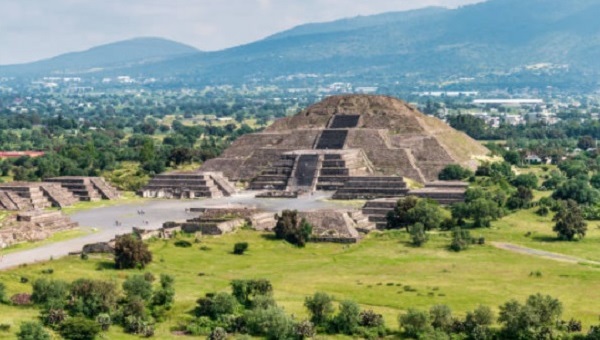
History of Aztec People
The Aztec civilization developed and flourished as a Mesoamerican civilization in and around the Valley of Mexico from the fourteenth to sixteenth centuries. The valley encompasses most of the modern Mexico City Metropolitan Area and eastern parts of the state of Mexico, Hidalgo, Tlaxcala and Puebla. It is surrounded by several mountains and volcanoes and boasts as a centre for many pre-Colombian Mesoamerican civilizations in the region. For instance, the Aztec people used to consider the people of the preceding Toltec civilization as their cultural and intellectual predecessors. The Triple Alliance or the Aztec Empire, an alliance of three Nahua altepetl (city-states), namely Mexica-Tenochtitlan, Tetzcoco and Tlacopan prospered in and around the Valley of Mexico until the Spanish forces combined with some other neighbouring tribes destroyed it in 1521 CE. The Aztecs called their city Tenochtitlan after a name, Tenochca, the Aztecs often used to describe themselves. The other name they so often used for self was Mexica. Nahuas are believed to be indigenous people of Mexico and other surrounding states, and Aztecs and Toltecs are ordinarily treated as of the same ethnicity.
Originally, the Aztec people addressed themselves as Mexica or Tenochchca, the latter name is a derivative of their capital city Tenochtitlan. The story of origin of Aztec people refers to a legendary homeland called Aztlan, whose exact identity is unknown but the scholars believe that by all probability this represents the modern-age Mexico. The capital city Tenochtitlan was built on a raised island of the Lake Texcoco and the modern day Mexico City is believed to have been raised on the ruins of that city. The Valley of Mexico comprised of many city-states around the mid-13th century, the most powerful among them being Culhuacan on the south shore of the aforesaid lake. The Mexica or Aztec people were a semi-nomadic tribe when they initially arrived in the valley of Mexico around mid-half of the 13th century and settled on Chapultepec, a hill on the west shore of Lake Texcoco. They were, however, forced to leave the place by other powerful tribes and then Cocoxtli, ruler of Barbara, permitted them to settle at the barren land of Tizaapan towards the end of the century where they started assimilating Calhuacan culture. The story goes that in 1323 CE, they proposed the new ruler of Culhuacan, Achicometl, to spare his daughter to make her the goddess Yaocihuatl. Later, realizing that the Mexica (Aztecs) actually sacrificed the princess in order to make her deity, the Culhuacan king forcibly evicted them from Tizaapan.
The Aztecs now shifted to another island on the west side of Lake Texcoco in 1325 CE and built their city Tenochtitlan. Available evidences suggest that the Aztec people elected their first tlatoani (king), Acamapichtli, in 1376 CE and, in the next few decades, they developed into the Aztec Empire or the Triple Alliance comprising of the three city states of Mexica-Tenochtitlan, Tetzcoco and Tlacopan. They ruled the area in and around the Valley of Mexico from 1428 CE to 1521 CE, when the combines forces of the Spanish invader aka conqueror Hernan Cortes and his native allies convincingly defeated ending the Aztec empire. In their peak glory, the empire had dominated the Gulf of Mexico and Pacific shores nearly for one hundred years before their fall and eventual decline.
The first king (tlatoani) of the Triple Alliance was Itzcoatl (1427-40 CE), who considerably expanded empire’s territory, conquering nearly a dozen big and small Nahua-speaking cities, including Cuauhnahuac (now Cuernavaca).
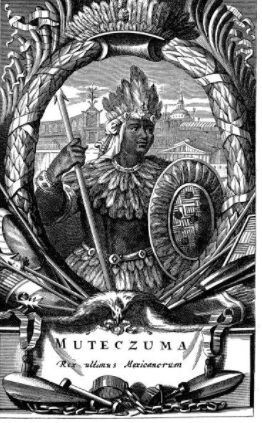 Next three decades (1440-69 CE) in Aztec history experienced instability with many successors; however, Moctezuma I as ruler and Tlacaelel as chief adviser and force behind the throne were most effective who further consolidated and expanded the area of empire through many conquests and bringing in several reforms. While Moctezuma I is accredited with several conquests, Tlacaelel established himself as the primary architect of the Aztec empire. He had a long tenure as something like a “Grand Vizier” through the reigns of four successive kings until his death in 1487 CE. He is known to have popularized the concept of the Aztecs as the chosen people, who also elevated one of the primary gods, Huitzilopochtli, to the highest position in the pantheon of gods. When their tenure started, the Aztecs were still a vassal state but by his end the Aztecs were socially well stratified and a powerful expansionistic empire.
Next three decades (1440-69 CE) in Aztec history experienced instability with many successors; however, Moctezuma I as ruler and Tlacaelel as chief adviser and force behind the throne were most effective who further consolidated and expanded the area of empire through many conquests and bringing in several reforms. While Moctezuma I is accredited with several conquests, Tlacaelel established himself as the primary architect of the Aztec empire. He had a long tenure as something like a “Grand Vizier” through the reigns of four successive kings until his death in 1487 CE. He is known to have popularized the concept of the Aztecs as the chosen people, who also elevated one of the primary gods, Huitzilopochtli, to the highest position in the pantheon of gods. When their tenure started, the Aztecs were still a vassal state but by his end the Aztecs were socially well stratified and a powerful expansionistic empire.
Axavacatl, the son of Moctezuma I, became ruler in 1469 CE. He annexed the kingdom of Tlatelolco on the pretext that his sister married to its king was constantly mistreated and then proceeded to conquer more small city-states west of the Valley of Mexico. He also faced a brief civil war when the subdued ruler of Tlatelolco allied with enemies of Aztec empire and waged a fresh war on him. They were, however, defeated and executed by Axavacatl. After his death in 1481 CE, his younger brother Tizoc rule for a brief stint (1481-86). His short tenure was marked with instability and turmoil and he was soon replaced by his younger brother Ahuitzotl, who is believed to have poisoned the elder brother to ascend the throne. The next significant king in the Aztec empire was Moctezuma II in 1502 CE. He is considered an able ruler and notable warrior who extended the tributary system and conquered new territories. It was during his time that the first engagement of the Spanish conquerors under Hernan Cortes and Aztec empire took place in 1519 CE and Moctezuma was killed at early stages in 1520 CE but the Spanish victory remained inconclusive at the time.
After the death of Moctezuma, his kinsman and adviser Cuitlahuac succeeded him as next tlatoani while the conflict with Spanish invaders was still underway. He, however, ruled merely for about eighty days and died of the smallpox epidemic. Following his death, Cuauhtemoc succeeded the Aztec throne, who proved out to be the last Aztec king. Cortes with his small army could not have done it alone; instead, he was supported by nearly two lakh native allies who were indigenous enemies and rivals of Aztecs from Tlaxcala and other tributary neighbouring city-states, envious with its glory and prosperity. King Cuauhtemoc valiantly defended Tenochtitlan but the Aztecs had already weakened due to prolonged siege and smallpox epidemic introduced by the Europeans in the region.
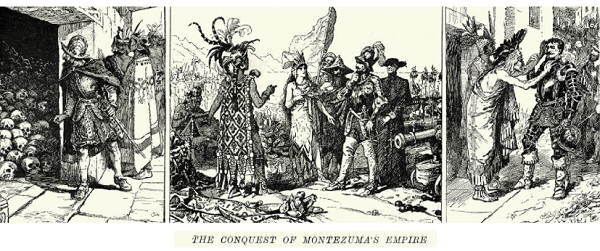
After a long siege and complete destruction of the Aztec capital, Cuauhtemoc was captured on 13 August 1521 paving way for the Spanish hegemony in Mesoamerica. Ultimately, the king too was tortured and executed at the orders of Cortes ending Aztec political history.
The Aztec society was hierarchical comprising of the pipiltin and macehualtin classes. The pipiltin represented about 5% of nobility with exclusive privileges in the society. For instance, only they had right to wear certain jewels and fine garments, consume luxury goods, and so on. The remaining population represented macehualtin, which included common people; about twenty percent of the population was engaged in agriculture and remaining eighty percent were from the warrior, artisan and trader classes. The society was highly gendered with distinct roles defined for the men and women. Men usually worked outside the house as the farmers, traders, craftsmen and warriors while women mainly took responsibilities of the domestic sphere; however, the latter’s role as-scale merchants, doctors, priests and midwives was not uncommon. Apart from taking care of domestic food production, women also weaved textiles from agave fibers and cotton while men engaged in many crafts work such as ceramics, tools, luxury goods and music instruments.
The society was mainly dependent on the agrarian economy with maize as the chief produce and source of livelihood, the other significant crops being beans, squashes, chilies and amaranth. For the agricultural purposes, the construction of chinampas (floating garden) was a common practice, which was basically small, stationary and artificial islands built on the shallow fresh water lake for the agricultural purpose. The markets were highly organized with supervisors ensuring that only authorized merchants were permitted to sell prescribed goods. The small towns had weekly market systems while in the larger cities business were opened every day. Aztecs did not produce much metal works but had the knowledge of smelting technology using gold with precious stones while copper products were usually imported from the Tarascans of Michoacan. The centerpiece of Tenochtitlan as also other major cities were the Templo Mayor, the Great Temple, a large stepped pyramid structure with double staircase leading to twin shrines dedicated to two gods Huitzilopochtli and Tlaloc, where the rituals of the human sacrifices were also in practice.
Aztec Pantheon and Deities
The Aztec religion was polytheistic and the people practiced the worship of a large number of male and female deities. The state patronized the worship of the deity who was installed in the central temple precinct of the capital Tenochtitlan and other major cities. In most cases, this deity was Huitzilopochtli, the distinctive patron god of the Aztec people, associated with war. The conquered people were allowed to continue their religious traditions and worship own deities as long as they also recognized and worshipped Huitzilopochtli and other Aztec deities. The Aztec pantheon was divided in at least four major groups of gods and goddesses patronizing different aspects of the universe. They were the water, sky, earth and fire deities. In addition, there were a large number of other gods and goddesses too, who were believed to supervise and patronized the day, night, death and matron issues. For the sake of brevity, only ten important gods and goddesses are discussed here.
1. Huitzilopochtli
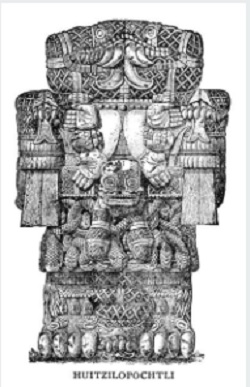 Huitzilopochtli is the supreme god of war, lord of the sun and fire, ruler of the South and patron of the city of Tenochtitlan. He was considered as the most fearsome and powerful deity among all the Aztec gods and goddesses. He was also remembered as the father of all Aztec people, his symbol was eagle and he wielded Xiuhcoatl, the fire serpent, as a weapon. The Great Temple in the centre of the capital city was built in his honour and god Tlaloc’s, and he was offered human sacrifices in great esteem on special occasions. The shrine Templo Mayor was decorated with human skulls and painted red to symbolize blood. Being patron god of the Aztecs, he was credited with both the victories as well as defeats that the empire people had during the wars with their enemies. He was also believed to be accompanied by the spirits of the martyred warriors, who returned to the earth as hummingbirds, as also the spirit of women died during the childbirth; and for these reasons, he was also acknowledged as the “Hummingbird of the South.”
Huitzilopochtli is the supreme god of war, lord of the sun and fire, ruler of the South and patron of the city of Tenochtitlan. He was considered as the most fearsome and powerful deity among all the Aztec gods and goddesses. He was also remembered as the father of all Aztec people, his symbol was eagle and he wielded Xiuhcoatl, the fire serpent, as a weapon. The Great Temple in the centre of the capital city was built in his honour and god Tlaloc’s, and he was offered human sacrifices in great esteem on special occasions. The shrine Templo Mayor was decorated with human skulls and painted red to symbolize blood. Being patron god of the Aztecs, he was credited with both the victories as well as defeats that the empire people had during the wars with their enemies. He was also believed to be accompanied by the spirits of the martyred warriors, who returned to the earth as hummingbirds, as also the spirit of women died during the childbirth; and for these reasons, he was also acknowledged as the “Hummingbird of the South.”
2. Tlaloc
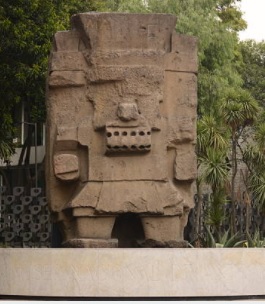 Tlaloc was the primary god of rain, lightning and thunder. He was considered to be a benevolent god associated with fertility, hence widely worshipped by the people as a beneficent giver of life and sustenance. Tlaloc was often depicted as the god wearing a mask with the large round eyes and long fangs. In mythology, he is often considered to have striking resemblance with the Mayan rain god, Chaak. He was marked with a strange contrast in that as benevolent deity he ushered in life giving rains for good crops but was also a destructive and unforgiving deity who sent hail, thunder, storms and drought when angry. He was also recognized as the ruler of the other-worldly paradise of Thalocan that sheltered the victims of the storms, floods and diseases like leprosy. Tlaloc was the second most worshipped deity among the Aztec people, with the second shrine on the top of the Templo Mayor dedicated to him in Tenochtitlan. Another interesting fact about him is that even after nearly five hundred years of the collapse of the Aztec empire, Tlaloc still carries a significant place and recognition in the Mexican culture.
Tlaloc was the primary god of rain, lightning and thunder. He was considered to be a benevolent god associated with fertility, hence widely worshipped by the people as a beneficent giver of life and sustenance. Tlaloc was often depicted as the god wearing a mask with the large round eyes and long fangs. In mythology, he is often considered to have striking resemblance with the Mayan rain god, Chaak. He was marked with a strange contrast in that as benevolent deity he ushered in life giving rains for good crops but was also a destructive and unforgiving deity who sent hail, thunder, storms and drought when angry. He was also recognized as the ruler of the other-worldly paradise of Thalocan that sheltered the victims of the storms, floods and diseases like leprosy. Tlaloc was the second most worshipped deity among the Aztec people, with the second shrine on the top of the Templo Mayor dedicated to him in Tenochtitlan. Another interesting fact about him is that even after nearly five hundred years of the collapse of the Aztec empire, Tlaloc still carries a significant place and recognition in the Mexican culture.
3. Tezcatlipoca
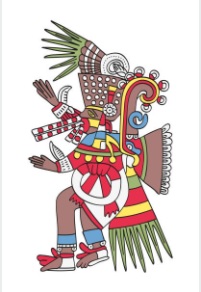 His name translates to “the smoking mirror” and he was Huitzilopochtli’s rival god and, as the god of providence, he was associated with a wide range of attributes and activities, including the night sky, the night winds, hurricanes, the north, the earth, hostility, obsidian, discord, rulership, temptation, sorcery, beauty, war, conflict, and so on. For these attributes, he is also considered evil and linked with the death and cold. Tezcatlipoca is often depicted with a black and a yellow stripe painted across his face and his right foot replaced with an obsidian mirror, bone, or even a snake, linking it to the creation myth in which he supposedly lost his foot battling with the Earth Monster. Tezcatlipoca's nagual, his animal embodiment, was the jaguar and this jaguar aspect was deified as Tepeyollotl (Mountainheart). He was among the most important gods in the Mesoamerican culture and, at a time span, even the supreme deity of Toltecs, the Nahua-speaking warriors from the north.
His name translates to “the smoking mirror” and he was Huitzilopochtli’s rival god and, as the god of providence, he was associated with a wide range of attributes and activities, including the night sky, the night winds, hurricanes, the north, the earth, hostility, obsidian, discord, rulership, temptation, sorcery, beauty, war, conflict, and so on. For these attributes, he is also considered evil and linked with the death and cold. Tezcatlipoca is often depicted with a black and a yellow stripe painted across his face and his right foot replaced with an obsidian mirror, bone, or even a snake, linking it to the creation myth in which he supposedly lost his foot battling with the Earth Monster. Tezcatlipoca's nagual, his animal embodiment, was the jaguar and this jaguar aspect was deified as Tepeyollotl (Mountainheart). He was among the most important gods in the Mesoamerican culture and, at a time span, even the supreme deity of Toltecs, the Nahua-speaking warriors from the north.
4. Quetzalcoatl
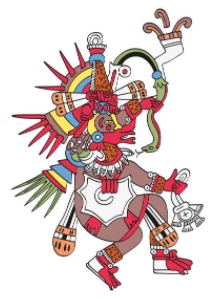 He was the brother of Tezcatlipoca and mainly remembered as the god of winds and rain, intellect, learning and self-reflection. Quetzalcoatl is depicted with a ehecacozcatl (wind breastplate) around his neck, which is the spirally voluted wind jewel comprised of a conch shell and his nagual was a mix of quetzal (the emerald plumed bird) and rattlesnake; hence he was often symbolized as the feathered serpent. He played a key role in many other Mesoamerican cultures too such as Teotihuacan and Mayan. The Aztecs also linked him with the planet Venus, mercantile, arts and crafts, and was considered by many as the patron of the priesthood. As the patron of science and learning, Quetzalcoatl is believed to have invented the calendar and books. According to a legend of the Aztec mythology, Quetzalcoatl had a dog-headed companion and the two had descended to the land of dead to collect the bones of the ancient dead and by infusing the bones with own blood, he regenerated the mankind.
He was the brother of Tezcatlipoca and mainly remembered as the god of winds and rain, intellect, learning and self-reflection. Quetzalcoatl is depicted with a ehecacozcatl (wind breastplate) around his neck, which is the spirally voluted wind jewel comprised of a conch shell and his nagual was a mix of quetzal (the emerald plumed bird) and rattlesnake; hence he was often symbolized as the feathered serpent. He played a key role in many other Mesoamerican cultures too such as Teotihuacan and Mayan. The Aztecs also linked him with the planet Venus, mercantile, arts and crafts, and was considered by many as the patron of the priesthood. As the patron of science and learning, Quetzalcoatl is believed to have invented the calendar and books. According to a legend of the Aztec mythology, Quetzalcoatl had a dog-headed companion and the two had descended to the land of dead to collect the bones of the ancient dead and by infusing the bones with own blood, he regenerated the mankind.
5. Coatlicue
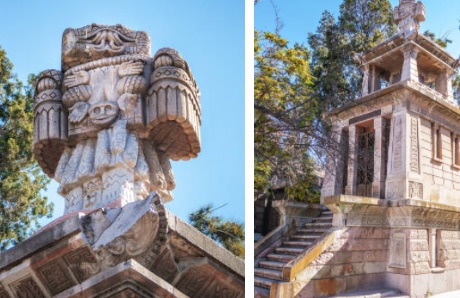
Coatlicue was venerated by the Aztec people as the mother goddess who was responsible for the procreation of many gods and mortals. In Aztec mythology, she was the feminine goddess who gave birth to the moon, stars and Huitzilopochtli. She is depicted as a woman wearing a skirt of writhing snakes and a necklace comprised of human hearts, hands, and skulls. Besides, her hands and feet are adorned with claws and breasts in a hanging flaccid form supposedly of pregnancy. Her face too is represented by two facing serpents commensurate with a myth that she was sacrificed at the beginning of the current creation. For these attributes, Coatlicue was much loved but feared as much by the people. She symbolized the antiquity of earth worship and of childbirth but was also linked with the governance, warfare and agriculture.
6. Tonatiuh
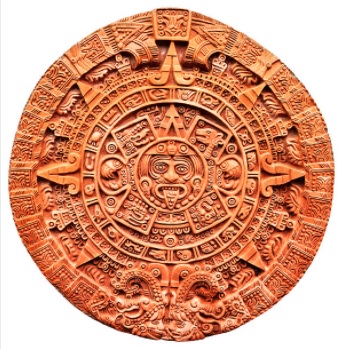
Tonatiuh was the Aztec sun god of the day time sky who ruled the cardinal direction of the east. He was considered as a nourishing deity that needed the sacrificial blood to render warmth to people and defeat darkness on the day-to-day basis. Some people even believed that his journey was sustained by the daily sacrifice of humans. Also he was the patron of warriors and depicted as a squatting man painted in the red colour and wearing an eagle feather headdress with a disk on his back or holding a solar disc, or even simply shown as a symbolic sun disk. According to Aztec mythology, there were many sun gods and Tonatiuh was fifth current sun god.
7. Chalchiuhtlicue
She was the Aztec goddess of water, rivers, streams, seas, storms, and was also closely associated with the fertility and childbirth. For these attributes, she was highly revered in Aztec culture. In Aztec pantheon, she is described as the wife, and sometimes even sister, of Tlaloc. Chalchiuhtlicue was depicted as the goddess wearing a green skirt and often associated with serpents. She is shown with a distinct headdress comprising of many broad bands of cotton and amaranth seeds and sometimes a stream of water flowing from behind her jade skirt. As patron of the childbirth, she was protector of both the mother and newborn child. In Aztec mythology, she had a key role in the deluge myth, where while being a catalyst for the cataclysmic flood, she transformed humans into fishes to save them.
8. Xipe Totec
Xipe Totec was yet another important god of the Aztec people with many attributes. He was the god of agriculture, vegetation, seasons especially of the spring as also considered as the deity of life, death and rebirth. He was patron of the east, goldsmiths, silversmiths and liberty. In Mesoamerica, he was also remembered with names like Tlatlauhca, Tlatlauhqui, Tezcatlipoca (Red Smoking Mirror) and Youalahuan. As the god of agricultural fertility, he was usually depicted wearing a flayed human skin symbolizing the death of the old and the growth of new vegetation but without the skin, he was shown as a golden god. Many Aztecs believed that it was Xipe Totec who invented war, and, accordingly, his insignia included the war attire of the Mexica emperor i.e., the pointed cap and rattle staff. He was worshipped with human sacrifice (usually enemy prisoners) during the March festival of Tlacaxipehualiztli (literal meaning: “flaying of men”).
9. Chicomecoatl
Chicomecoatl was the goddess of agriculture, plenty, nourishment and corn. The literal meaning of her name is seven snakes and she was usually depicted with the red ochre on the face, paper headdress on top, water-flowers patterned shirt and foam sandals on the bottom. She was regarded as the female counterpart of the maize god Centeotl, the symbol being an ear of corn. She was the wife of Tezcatlipoca and was often shown as a young girl carrying flowers or the motherly woman with a sun shield.
10. Mictlantecuhtli
In Aztec mythology, Mictlantecuhtli is the most prominent god of the dead who ruled, along with his wife Mictecacihuat, the Mictlan, the lowest and northernmost part of the underworld. His worship occasionally involved even ritual cannibalism, with human flesh consumed in and around the temple. He was remembered with some other names too such as Ixpuztec (Broken Face), Nextepehua (Scatterer of Ashes) and Tzontemoc (Who Lowers His Head). He was depicted as a blood-spattered skeleton or a person wearing a toothy skull, with eye sockets having proper eye balls. His headdress contained owl feathers and he wore a necklace of human eyeballs. He was believed to live with his wife in a windowless house in Mictlan and they were symbolized with spiders, owls and bats.
Apart from the aforesaid principal gods and goddesses, there were numerous other major and minor deities in the Aztec pantheon patronizing various aspects and things that existed in nature and affected people in some way. In the pantheon, the priests were very powerful, and enjoyed high position and reverence in the Aztec society. They were responsible for the offerings and sacrifices to deities as also to conduct various ceremonies in the temples. Although the custom and instances of ritualistic human sacrifice are reported from many of the ancient civilizations, but apparently it was practiced by Aztecs at a fairly large scale as many of them believed that the sun needed the blood of human sacrifice in order to maintain its daily journey and warmth to the people. They also believed in afterlife with several levels of the heaven and underworld. According to the contemporary belief, people would go to heaven or underworld depending upon the circumstances of death; for instance, warriors who died in the battlefield would achieve top level of the heaven while the person drowned would go to the underworld. The Aztecs participated in a number of religious ceremonies and festivals, the largest and most pious being the festival of Xiuhmolpilli (new fire). They thought they were living under the fifth, and final, sun and that when the fifth sun would die, the world would also come to an end.
Aztec Mythological Legends
In Aztec culture, the mythology and religion had played a key role in shaping and conducting the lives of people. The Aztecs were one of the Nahuatl-speaking groups of people in the central Mexico and their mythology too is similar to other Mesoamerican cultures. However, the exact origin of the Aztecs is still unknown: According to a legend, they had arrived from Aztlan in the north to the Anahuac valley around the Lake Texcoco; other narratives suggest their origin from Chicomoztoc i.e. the place of seven caves, or Tamoanchan, a mythical place of origin of all civilizations. Even the establishment of their capital city Tenochtitlan is linked with a prophecy of the god Huitzilopochtli in sending an eagle holding a rattlesnake in its talons perched on a nopal cactus. Thus many fables and legends are associated with the origin and creation of civilization, its gods, goddesses and Aztec mortals, and few representative tales are briefly narrated here.
1. Birth of Patron God Huitzilopochtli
The mother goddess Coatlique, often depicted as the Lady of the Skirt of Snakes, is associated with the creation legends of the Aztec civilization. Coatlique was once impregnated by an obsidian knife and gave birth to Coyolxanuhqui, the goddess of moon, and a group of four hundred male offspring that represented the stars. Then one day Coatlique found a ball of feathers while she was sweeping a temple, which she initially tucked into her bosom. However, when she looked for it later, it had disappeared but then she realized that she was pregnant again. The children moon and stars, however, could not believe her story of pregnancy as they thought that a goddess could give birth only once to a litter of divinity and even the talk of another pregnancy was sin. Therefore, ashamed of their mother, the children decided to kill her and started plotting accordingly. However, before they could succeed in their design, Coatlicue gave birth to Huitzilopochtli, the fiery god of war. In the ensuing war, Huitzilopochtli destroyed his estranged sister moon and brother stars with the assistance of a fire serpent. He beheaded Coyolxauhqui; he threw her head into the sky to permanently stay there as moon while her dismembered body was thrown into a deep gorge in a mountain only to lie there forever. He chased and beheaded brothers too, who were scattered in sky to stay as permanent stars.
2. The Deluge Myth - Tata and Nena
During the time of the fourth sun, the Sun of Water, the people had become very selfish and wicked, and even stopped the worship of the gods. So the gods became very angry and Tlaloc, the god of rains, decided to annihilate the world with a great deluge. However, there was one couple, Tata and Nena, who were still faithful to gods and lived a pious life according to the principles of the truthful living on the earth as laid down for the human being by the gods. Tlaloc mercifully decided to save them to avoid complete annihilation of the human race from the earth and, accordingly, cautioned them about the imminent flood and asked them to hollow out a huge log, but take only two ears of corn along with them to eat and nothing more - one for each of the two.
Tata and Nena complied with the instructions of god Tlaloc and entered the hallowed tree trunk with only two ears of corn. Immediately, it began to rain that continued for days unstopped and everything on the planet was destroyed in the great deluge. When the rain stopped and water subsided, and the log containing the two survived souls landed on the dry land, Tata and Nena were so joyful with the safe landing that they caught a fish and ate it forgetting the instructions of Tlaloc. It was only after their bellies were full that they realized their mistake. At this point, unhappy and angry Tlaloc appeared before them and said, “So, this is how I am repaid for saving your lives!” He punished them by turning them into dogs. A point was reached when even the most righteous people had become disobedient, so the gods destroyed the world, and recreated the present era of the Fifth sun.
The deluge myth of the Aztec culture is different from the similar legends of the old world civilizations wherein the people chosen by gods start the new life on the planet with seeds of animals and plants carried and saved by them.
3. The Tale of Five Suns
According to the Aztec mythology, people are living in the era of the fifth sun, and previous sun eras were destroyed at various points of time. The brief account of the four previous sun eras is as follows:
The first sun was the ‘Sun of the Ocelot’. During this period, the entire world was shrouded in utter darkness and the human beings lived only with the animal instincts alone lacking the thoughts and reasons. In the absence of wisdom and foresight, they were eventually eaten by ocelots paving the onset of the second sun. (Ocelots are medium-sized wild cats of orange-yellow tinge with black stripes and spots, which are native to the Central and South America.)
The second sun was the ‘Sun of Air’, when the world was dominated with the spirits and transparent beings. The human beings of this time did not have necessary wisdom and understanding to learn the requisite principles to be redeemed from their sins; therefore, the gods turned them all into monkeys and decided to recreate the world. There are different legends too about the rivalry of gods and the consequential impact on the life on earth.
The third sun was the ‘Sun of Fire’. During this period too, the human beings were ignorant and did not worship gods. So the world was destroyed with all rivers dried up finishing the aquatic life and all terrestrial creatures were killed by the roaring flames; only with the exception of few birds, who flew to safety. The fourth sun was the ‘Sun of Water’. During this period, people had become selfish and wicked ignoring the gods; hence Tlaloc, the rain god, had destroyed all the people in a great flood.
According to Aztec mythology, the current civilizations in the world represented the era of fifth sun. During this period, all the four primal energies and concepts of life viz., animal energy, water, air and fire are available and maintained in the requisite balance. Yet none can guarantee and people should not take it for granted that this sun will last forever and the continued existence of it would depend upon following the "ladder of redemption" prescribed in the Aztec calendar and by observing rituals. The essential point to be kept in mind is if the gods are ignored again, this sun too will die along with all civilization.
4. The Rag-Picker and the Priest
Once upon a time, a Nahua rag-picker found a painted book near the temple of Huitzilpochtli. He confided with priest and two together discovered that the book revealed about the secret of a magical casket hidden under the ninety-third step of the pyramid. Having agreed to equally share the treasure between them, they dug out the casket bound in a silver chain. Inside the casket, they found a magical rattle and drumstick, a mirror that could reveal future, a magic wand, an almanac and a book of sorcery. The priest told the rag-picker that the casket contained sacred things which were of no use to the latter and he offered three hundred gold coins to him in lieu of his share, to which the rag-picker instantly agreed.
However, while the priest was counting coins, the rag-picker hit on his head with the magic wand killing him and threw the priest’s body in the lake. The rag-picker kept the money and started studying the sacred artifacts himself. But he didn’t know how to decode things: He failed to read almanac; he visualized future that he couldn’t understand; he tried with rattle but its noise made him nervous; and he tried to sleep but strange spirits constantly kept on disturbing him. Next morning, he packed all things in the casket and threw them into the lake. As soon as he did it, the priest became alive and jumped out of the lake with casket in his hand. Now it was his turn; he used the magic wand to kill the wicked rag-picker and retained the sacred items in his custody so that the things did not cause harm to anyone again. The moral of the Aztec fable is that the sacred things shall remain in the worthy hands only.
Epilogue
Needless to mention, like other civilizations of the Central and South Americas, the Aztec people too became the victims of colonization, mass killing and conversion by the Spanish invaders and Christian crusaders of the time. The Aztec civilization had flourished in the Mesoamerican region where many pre-Colombian cultures had flourished for over a millennium before the Spanish invasion and colonization of the Americas. This was also one of the five important regions in the world where the ancient civilizations had evolved by and large independently on the pattern of the contemporary European, African and Asian cultures. Alas! The European colonizers and Christian missionaries were not only responsible for the inhuman treatment and excesses on the natives through massive killing and conversion of the Mexica people (Aztecs) but they also carried with them many Eurasian fatal diseases such as smallpox and measles to Americas, which were new to these American natives and caused deaths upto ninety percent and above in certain cases.
Images (c) istock.com
03-Oct-2021
More by : Dr. Jaipal Singh